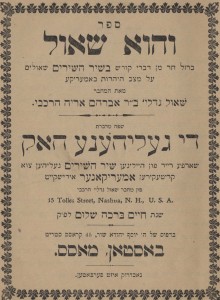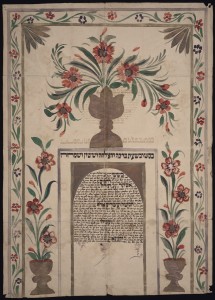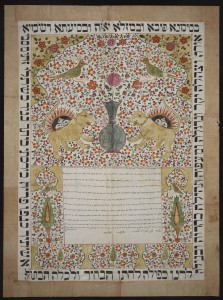Title of a portfolio by the artist Mark Podwal.
42 archival pigment prints of acrylic, gouache and colored pencil works on paper exhibited at the Terezin Ghetto Museum from April to July 2014. Includes folio with the titles, Hebrew psalms and descriptions of the all the artworks. Prints housed in an archival clamshell case imprinted with “ALL THIS HAS COME UPON US…” and the artist’s name. Edition limited to 60 numbered copies signed by the artist
According to the artist’s statement in the catalog accompanying the exhibit, “the paintings and drawings in this series are a disturbing reminder of how Europe’s extensive history of ‘Jew-hatred’ laid the groundwork for Terezin and Auschwitz.” Each image, depicting a tragedy or injustice in Jewish history from slavery in Egypt through the Holocaust is paired with a verse from Psalms. “The menorah in the first image, carried away by goose stepping Germans, appears again in the last image with the seven biblical fruits sprouting from its branches. A verse from Psalm 126, the psalm almost chosen as Israel’s national anthem, proclaims, ‘Those who plant with tears will harvest in joy.’ ”
See a selection from prints of Podwal’s work below:

Psalm 94:3– “How long will the wicked triumph?”
“Rabbinic sages say in the human heart are two impulses, good and evil. The wicked, influenced by the evil impulse, destroyed the Temple and exiled the Jews from their land. Against the evil impulse, the Torah is the great antidote.”

Psalm 60:6–“You give your loyal followers a banner around which to rally.”
“Every year, when the annual reading of the Torah concludes and begins anew the congregation says in Hebrew, ‘Chazak, chazak, v’nitchazek’ meaning ‘Be strong, be strong, and may we strengthen one another.”

Psalm 122:6– “Pray for the peace of Jerusalem, may those you love You be at peace.”
“Though Jerusalem is called ‘City of Peace,’ no place has been fought over more.”

Psalm 13:3– “How long will I have troubling thoughts, sorrow in my heart every day? How long shall my enemy dominate me?”
“In both Christian and Muslim countries, it was common for laws to mandate that synagogues could not be taller than churches or mosques.”
Two new pieces in our collection:

Saul Gedaliah HarkavyVehu Sha’ul – DI Gelihene Hok. First Edition. Text in Hebrew and Yiddish. With supplement “Der Zeiger”—concerning the Rabbis of America who incessanty argue with each other.
An anti-assimilationist polemic, written in the form of a running commentary to the Song of Songs by a Mir and Volozhin-educated immigrant to Nashua, NH. The author holds up absolutely no hope for a Jewish future in America—only in the Land of Israel can Judaism be certain. “Having dwelt in this land (of America) for a number of years and having seen the disgraceful behavior of my people…I can no longer restrain myself and must make public what weighs so heavily on my heart.

Isak Lechter. In Land Fun Rasen Diskriminatziya (On Racism in America) Yiddish. Warsawm Yiddish Buch Verlag, 1953.
The Yale University Library has a large collection of illuminated ketubot (Jewish marriage contracts). Below are some examples from our collection.

Marriage contract, manuscript, ink and paint on paper, dated 3rd of Kislev 5649 (1888) at Yerushalem. Document has a scalloped top with two registers. The lower register contains the text of the ketubah and the upper register contains a vase and branches with flowers. The two registers are bordered by a design of blue leaves with red and yellow flowers.

Marriage contract, manuscript, ink and paint on paper, dated 9th of Nisan, 5665 (1905) at Dameśeḳ. The text is written within an arched gilded border in the bottom half of the document. Above it and on both sides are painted large vases with flowers and borders with floral designs. Beneath the text of the ketubah are the signatures of the two witnesses on either side and the groom’s signature in the center.

Marriage contract, manuscript, ink on vellum, dated 7 Tamuz 5549 at Saloniki, Greece. Surrounding the two columns of text are birds, flowers, fruit, columns, biblical sayings, Eshet Hayil, Shir ha-shirim. The right column contains the marriage terms and the left column contains the betrothal terms. Colors used are brown, with coral & dark grayish blue-green.

Marriage contract, manuscript, ink and paint on paper, dated 12th of Nisan 5616 (1856) at Itsfahan, Iran. Brightly colored elaborate floral illumination surrounds the text. In the center above the text there is a large vase with two lions with a rising sun behind them on either side of the vase, and with two birds above. There is a floral arch on the top of the document and two smaller arches framing the text. The frame of the document contain blessings for the bride and the groom.
Among Yale Library’s extensive collection of sheet music is the Yiddish opera, Bas Sheva.  The opera in Yale’s possession is in manuscript form. The lyrics are romanized, probably because musical notes can only be written from left to right, whereas Yiddish is read from right to left. The title page can be considered a work of art in itself, and in all probability Broderzon is the illustrator. Sometimes called Dovid and Bas-Sheva¸ this opera premiered in Warsaw’s prestigious Kaminski Theater on May 14, 1924. It is not known if it was ever performed again. Moishe Broderzon (1890-1956), the librettist, was born in Moscow but made his home in Lodz, Poland, where he did his most important artistic work. He was involved in just about every aspect of Yiddish culture and art. A poet and a playwright, he helped found a literary journal, a puppet theater, and a cabaret theater. He fled to Russia at the outbreak of World War II. Broderzon was arrested by the Soviet authorities in 1950 and died shortly after being released from a Stalinist labor camp. Henekh Kon (1998-1972) was a composer of musical theater and film. He is probably best known as the composer of the musical score for the Yiddish film The Dybbuk, based on S. Ansky;s play. Kon was a major figure in the Polish-Jewish cultural scene of the interwar period. He worked with Broderzon in founding the Chad Gadya marionette theater in Lodz (1922) and the Azazel (1925), Sambatyon (1926), and Ararat (1927) theaters in Warsaw. Kon left Poland before World War II and moved to New York. He thus survived the terrible fate that befell other Yiddish artists and intellectuals who were swept up in the Nazi inferno or the Stalinist persecutions. The Yale Library’s large collection of Yiddish and Hebrew sheet music is housed in the Gilmore Music Library.
The opera in Yale’s possession is in manuscript form. The lyrics are romanized, probably because musical notes can only be written from left to right, whereas Yiddish is read from right to left. The title page can be considered a work of art in itself, and in all probability Broderzon is the illustrator. Sometimes called Dovid and Bas-Sheva¸ this opera premiered in Warsaw’s prestigious Kaminski Theater on May 14, 1924. It is not known if it was ever performed again. Moishe Broderzon (1890-1956), the librettist, was born in Moscow but made his home in Lodz, Poland, where he did his most important artistic work. He was involved in just about every aspect of Yiddish culture and art. A poet and a playwright, he helped found a literary journal, a puppet theater, and a cabaret theater. He fled to Russia at the outbreak of World War II. Broderzon was arrested by the Soviet authorities in 1950 and died shortly after being released from a Stalinist labor camp. Henekh Kon (1998-1972) was a composer of musical theater and film. He is probably best known as the composer of the musical score for the Yiddish film The Dybbuk, based on S. Ansky;s play. Kon was a major figure in the Polish-Jewish cultural scene of the interwar period. He worked with Broderzon in founding the Chad Gadya marionette theater in Lodz (1922) and the Azazel (1925), Sambatyon (1926), and Ararat (1927) theaters in Warsaw. Kon left Poland before World War II and moved to New York. He thus survived the terrible fate that befell other Yiddish artists and intellectuals who were swept up in the Nazi inferno or the Stalinist persecutions. The Yale Library’s large collection of Yiddish and Hebrew sheet music is housed in the Gilmore Music Library.
A group of manuscripts that we have assembled over a period of several years is the rabbinic emissaries collection. In Hebrew they were referred to as shadarim, an acronym for shilluhe de-rabbanan.
![Rabbinic emissary document from Tiberias to communities in Tunisia and Libya, 1922. Large manuscript on parchment, dated 5682 [1922], intended as a letter of introduction in which the great sages of Tiberias authorize Rabbi Yaʻaḳov Ṿaḳnin to collect funds for the needy of that city. The first five paragraphs each begin and end with the same word. The top of the document is scalloped with the center taking the form of an arch. The calligraphy is beautifully executed, indicating that the document was probably written by a professional scribe. The document bears the signatures and official stamps of over forty rabbis from the Maghrebi community in Tiberias. The letter is addressed to rabbis and leaders of the large centers of Jewish settlement in Tunisia and Libya. The great Talmudic sage Rabbi Meir, also known as Rabbi Meir Baal ha-Nes, whose tomb is in Tiberias, is referred to frequently to add more gravity to the request of the emissary and the rabbis who sent him.](https://campuspress.yale.edu/judaicacollection/files/2013/11/2012-10-03_12-15-07_686-169x300.jpg)
Rabbinic emissary document from Tiberias to communities in Tunisia and Libya, 1922.
Large manuscript on parchment, dated 5682 [1922], intended as a letter of introduction in which the great sages of Tiberias authorize Rabbi Yaʻaḳov Ṿaḳnin to collect funds for the needy of that city.












![Rabbinic emissary document from Tiberias to communities in Tunisia and Libya, 1922. Large manuscript on parchment, dated 5682 [1922], intended as a letter of introduction in which the great sages of Tiberias authorize Rabbi Yaʻaḳov Ṿaḳnin to collect funds for the needy of that city. The first five paragraphs each begin and end with the same word. The top of the document is scalloped with the center taking the form of an arch. The calligraphy is beautifully executed, indicating that the document was probably written by a professional scribe. The document bears the signatures and official stamps of over forty rabbis from the Maghrebi community in Tiberias. The letter is addressed to rabbis and leaders of the large centers of Jewish settlement in Tunisia and Libya. The great Talmudic sage Rabbi Meir, also known as Rabbi Meir Baal ha-Nes, whose tomb is in Tiberias, is referred to frequently to add more gravity to the request of the emissary and the rabbis who sent him.](https://campuspress.yale.edu/judaicacollection/files/2013/11/2012-10-03_12-15-07_686-169x300.jpg)